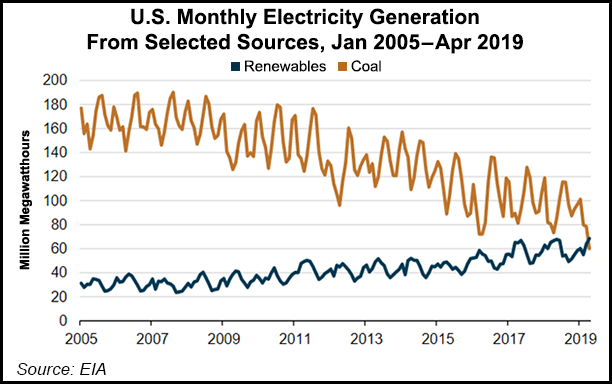NGI The Weekly Gas Market Report | Infrastructure | Markets | NGI All News Access
Renewables Gain Edge Over Coal in U.S. Power Generation for First Time, Says EIA
Renewable sources of fuel overtook coal in April U.S. power generation for the first time, according to the latest data from the Energy Information Administration (IEA).

Renewable fuel sources, namely wind, solar and hydroelectric, accounted for 23% of total electricity generation in April, up from 20% in March and up from 22% in April 2018.
Coal-fired power accounted for 20% of electricity generation in April, down from 24% in March and down from 24% a year ago.
Natural gas-fired power still accounted for a larger share of domestic generation at 35%, on par with March gas-fired power and up from 33% in April 2018.
Record monthly highs in wind power, near-highs in solar power and seasonal increases in hydroelectric power all contributed to the flip in market share between renewables and coal, the EIA said.
Wind-powered generation in April reached 30,217 MWh, while solar reached 6,949 MWh. The EIA expects solar powered generation in June to break its year-ago record of 7,800 MWh.
In addition to the ramp-up of renewables, the steady decline of coal-fired power also contributed to the shift. Since 2015, 47 GW of coal capacity has been retired, and the EIA expects another 4.1 GW of coal capacity to go offline this year, despite policy shifts championed by the Trump administration.
That being said, the EIA still anticipates coal to outstrip renewables on an annual basis for the remainder of 2019 and during 2020. However, renewables should top nuclear-fired power in 2020.
The rise of natural-gas fired power has also put increased pressure on coal-fired power plants over the past year.
Natural gas-fired combined-cycle (NGCC) power plants, which accounted for about one-half of all domestic gas-fired generating capacity at the end of 2018, became the technology with the most electricity generating capacity in the United States, surpassing coal-fired plants, the EIA has said.
NGCC power plants generated 90% of total gas-fired power last year.
© 2024 Natural Gas Intelligence. All rights reserved.
ISSN © 1532-1231 | ISSN © 2577-9877 | ISSN © 1532-1266 |
